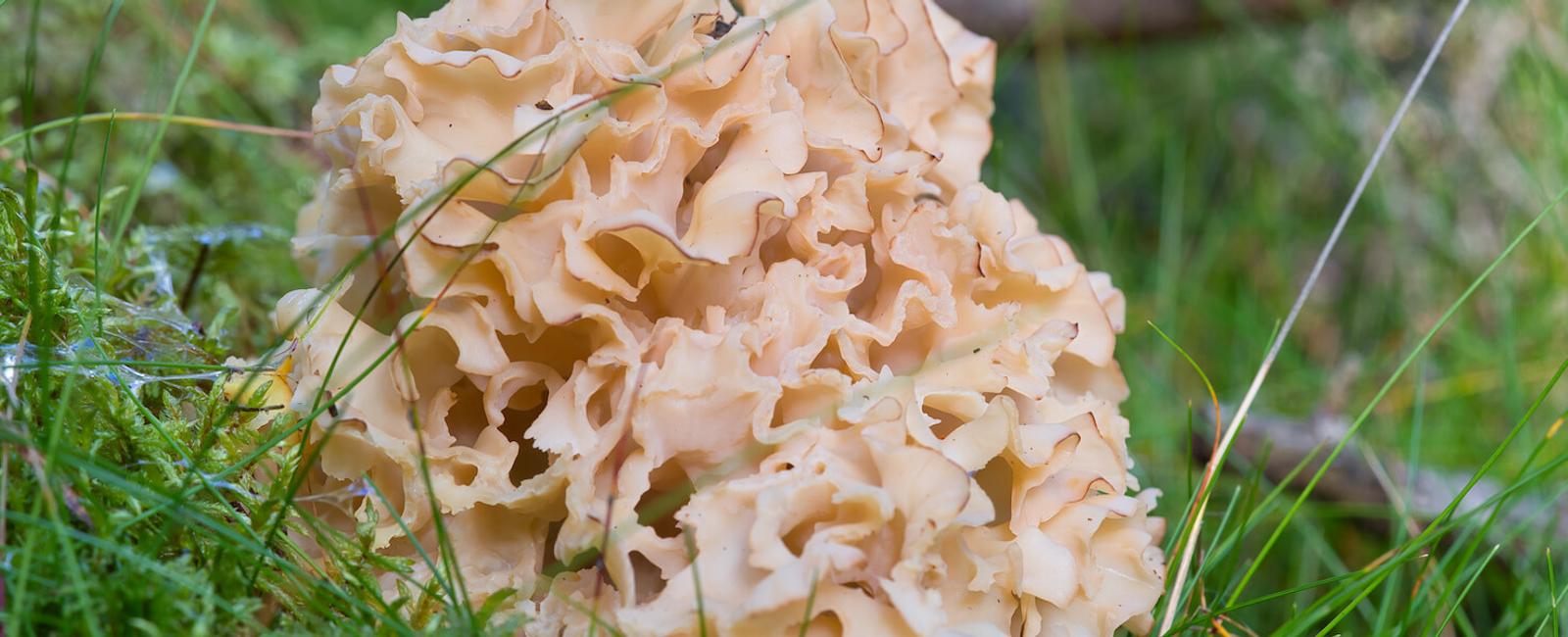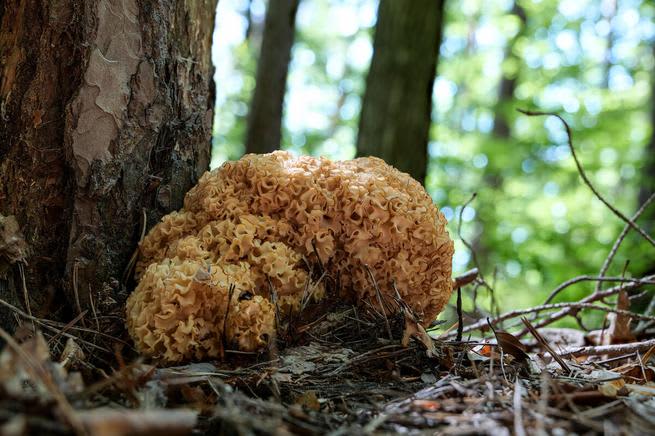

If it feels like there’s always a fascinating new mushroom to explore, that’s because there is. It’s estimated there are over 2,300 species of edible and medicinal mushrooms, and people are enjoying wild-grown mushrooms more than ever. One of these edible species is the cauliflower mushroom.
In this guide, you’ll learn all about cauliflower mushrooms. We’ll talk about what they are, where they grow, how to ethically wildcraft cauliflower mushrooms, and much more. Let’s jump in!
What are cauliflower mushrooms?
Cauliflower mushrooms (sparassis crispa) are edible mushrooms. Sometimes called wood cauliflower or the noodle mushroom, these mushrooms resemble a head of cauliflower (or egg noodles, brain coral, or a sea anemone). Some cauliflower mushrooms may be up to 50 pounds, although this doesn’t happen everywhere. You’ll likely find these giant shrooms in native old-growth fir forests in the Pacific Northwest (1).
Cauliflower mushrooms are parasitic, which means they feed off their host, which sometimes means the host dies. They can also cause brown rot in the trees they infect. They’re also adaptive and can live on dead stumps, which also means they’re saprobic and derive their nutrients from breaking down dead and decaying matter (2).
Psst: There are several sparassis species, including sparassis radicata, sparassis laminosa, and sparassis herbstii, which all look very similar. There’s debate around another species, sparassis spathulata, with some scientists thinking it may best be categorized as a separate species altogether (1).
What do cauliflower mushrooms look like?
As their name suggests, cauliflower mushrooms look similar to a head of cauliflower. However, their appearance shifts and changes slightly as they age.
When young, they’re a whitish-yellow color and resemble cauliflower florets. As they mature, they may look a little more like a brain or a bundle of egg noodles. They’ll develop a wavy, leaf-like structure that’s more of a creamy yellow color and their edges darken with age.
Wild cauliflower mushrooms are often larger than their cultivated counterparts (1).
Where do cauliflower mushrooms grow?

Favoring older forests, cauliflower mushrooms are found throughout temperate regions of Europe and North America, growing at the base of conifers (pine trees like Douglas Firs and spruces). It’s slightly different on the East Coast and in Europe, where these mushrooms prefer hardwoods such as oak. Their growing season lasts from late July through November (1).
Historical and traditional use of cauliflower mushrooms
There’s evidence that cauliflower mushrooms have been used in traditional Chinese medicine because of their remarkable health benefits (more on those soon). Recently, they’ve become more prevalent in Japan and Korea.
Without more documentation, we cannot be more specific about how cauliflower mushrooms feature in traditional medicine schools. But we can speak to how modern science is discovering just how many health benefits there are to consuming these mushrooms.
Health benefits of cauliflower mushrooms
Emerging research is uncovering the wealth of health benefits cauliflower mushrooms offer. So far, scientists have found cauliflower mushrooms to have antitumor and anticarcinogenic properties along with anti-inflammatory, antiviral, antihypertensive, anti-allergic, and anti-diabetic properties. Even more, cauliflower mushrooms may boost the immune system through cytokine induction.
Cauliflower mushrooms are high in beta-glucans, which support the body by preventing and healing health conditions such as cancer, diabetes, wound healing and boosting the immune system. Studies on animal and human cell lines have shown that cauliflower mushrooms possess health benefits that may prevent several diseases and health conditions (3).
Ethical wildcrafting of cauliflower mushrooms

While you may be eager to grab your satchel and pack a lunch for an afternoon of foraging, there are a few things to learn about ethically wildcrafting cauliflower mushrooms before venturing out. Even though ethical wildcrafting and foraging seem similar, there are some important distinctions to know.
Foraging is typically used as a catchall term for gathering wild food sources. Conversely, wildcrafting is more specific and refers to harvesting local resources for medicinal needs. Wildcrafting also considers the effects of harvesting a resource on the local environment.
Learning the local area
Before gathering cauliflower mushrooms, learn more about the environment where you’ll be harvesting your mushrooms. You may need permits or other special permissions depending on where you plan to collect your mushrooms.
Research local mushroom species you could encounter and whether or not they’re threatened or endangered, and determine if there are any dangerous lookalikes you could run into. A mushroom mixup can sometimes be deadly, so consult a field guide or a professional who can help you safely identify any wild mushrooms you harvest.
Mushroom anatomy and proper harvesting
If you’re gathering wild mushrooms, you’ll want to familiarize yourself with the anatomy of a mushroom. While it’s easy to think we’re seeing the whole mushroom, we only see part of it. Underneath the fruiting body (the part we see above ground), there’s another equally fascinating and essential aspect of a mushroom—the mycelium.
Made up of delicate filaments called hyphae, mycelium is an essential part of a mushroom as it helps with nutrient uptake and acts as a communication network for mushrooms and the world around them.
Proper harvesting techniques ensure the mycelium is left intact so the mushroom can continue reproducing. Be sure to bring the appropriate tools for what you’re harvesting. There is debate over whether it’s best to gently twist a mushroom free or carefully cut it at the base. Regardless of your chosen method, keep the mycelium intact as much as possible.
Ecosystem preservation
Another essential element of ethical wildcrafting is remembering we aren’t the only ones who delight in having mushrooms on our dinner plates. Birds, deer, squirrels, insects, and rodents all feast on mushrooms.
When wildcrafting your cauliflower mushrooms, gather only what you need. Overharvesting can throw a delicate ecosystem out of balance, which could create long-standing issues later on.
Consider making a spore print if you’re open to growing your favorite wild mushrooms at home. A spore print is precisely what it sounds like. It’s an easy way to save the spores from your mushroom harvest so you can germinate them at home.
How can you enjoy cauliflower mushrooms?

Like other wild mushrooms, cauliflower mushrooms are a delicious addition to many dishes, from soups and stir-fry to simple sautes and pasta.
There’s one thing to remember: these mushrooms release a lot of moisture, more so than most mushrooms. If you’re going to substitute these mushrooms into any dish, consider the extra cooking time. Without further ado, here are some of our favorite mushroom recipes featuring this flavorful fungi.
Mushroom quiche
Quiche may be the perfect make-ahead, clean-out-the-refrigerator type of dish. It’s adaptable to various dietary needs and preferences, making it an easy breakfast, snack, or lunch with a salad. And this over-the-top mushroom quiche is well worth the time—consider this a perfect weekend cooking project.
While you can use any mix of mushrooms (oyster, chicken of the woods, chanterelle, and morel mushrooms), it would be the perfect opportunity to use freshly gathered cauliflower mushrooms. Saute your mushrooms with shallots, butter, and fresh thyme for a filling rich with umami flavor. And here’s the difference between this recipe and other quiche recipes you may have tried: instead of baked eggs, you’re making a custard. Once it sets up overnight in the refrigerator, it makes for a not-so-run-of-the-mill, truly delightful quiche.
Creamy mushroom pasta
Easy breezy Mediterranean on a weeknight is here. This creamy mushroom pasta makes it easy to cook a delectable dinner that tastes even better than takeout from your favorite Italian restaurant. With minimal prep time (just 10 minutes) and a cooking time of 20 minutes, you can have dinner for your whole family (or leftovers for later in the week) in under an hour.
Start by sauteing shallots with a mixture of butter and olive oil over medium heat before cooking your cauliflower mushrooms (or a combination of shrooms) over medium heat to golden brown perfection. Garlic, merlot, black pepper, and parmesan combine, creating a silky smooth sauce sans cream. Drench your al dente pasta with this decadent sauce, and if needed, thin it out with a little more pasta water.
Mushroom risotto
While it’s not quite low-carb, if you’ve been looking for a decadent side dish equally suited for company as it is for yourself, look no further than this mushroom risotto. Made with a mix of mushrooms, this creamy risotto calls for white wine, garlic, fresh thyme, and pecorino cheese. Save a few bits of cauliflower mushroom to fry up at the end for a crispy garnish alongside the freshly chopped parsley.
Psst: Mushrooms are best stored in a paper bag in your refrigerator. Once you’re ready to use them, brush off debris with a paper towel or pastry brush. Remember that mushrooms release lots of moisture, so cook them long enough for them to begin caramelizing. Also, add salt closer to the end of cooking than at the start. Early salting can change the texture, making them rubbery or tough.
Cauliflower mushrooms: An unusual forest-dwelling mushroom
It’s hard to miss a mushroom as unusual-looking as a cauliflower mushroom. These mushrooms look like something you’d find under the sea instead of a forest floor strewn with pine needles. With delicious flavor and impressive health benefits, it’s no wonder they’ve found a place in kitchens and traditional medicine schools.
Be sure to keep up with all things mushroom on shroomer, where you’ll learn more about identification and all the latest breakthroughs and discoveries on functional and psychedelic mushrooms.
References
Stamets, Paul. Growing Gourmet and Medicinal Mushrooms. Ten Speed Press, 2011. https://fungi.com/collections/books-by-paul-stamets/products/growing-gourmet-and-medicinal-mushrooms
Mushroom Identification - Ultimate Mushroom Library. “Sparassis Crispa: The Ultimate Mushroom Guide,” n.d. https://ultimate-mushroom.com/edible/57-sparassis-crispa.html
Ngoc, Le Thi Nhu, You-Kwan Oh, and Young Chul Lee. “Effects of Sparassis Crispa in Medical Therapeutics: A Systematic Review and Meta-Analysis of Randomized Controlled Trials.” International Journal of Molecular Sciences 19, no. 5 (May 16, 2018): 1487. https://doi.org/10.3390/ijms19051487


